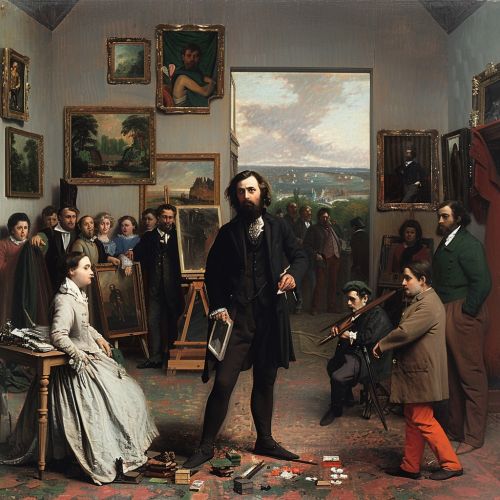Gustave Courbet
Early Life
Gustave Courbet was born on June 10, 1819, in Ornans, a small town in the Franche-Comté region of eastern France. He was the eldest of four children born to Régis and Sylvie Courbet, prosperous farmers who also owned extensive vineyards in the region. From an early age, Courbet showed a talent for drawing and painting, and his parents encouraged his artistic pursuits.
Education and Early Career
In 1839, Courbet moved to Paris to study at the Académie des Beaux-Arts, the premier art school in France. However, he found the academic style of painting taught there stifling and soon left to pursue his own artistic path. Instead of the idealized historical and mythological scenes favored by the Academy, Courbet chose to paint scenes from everyday life, a choice that would define his career and make him a pioneer of the Realist movement in 19th-century French painting.


Realism and the Salon
Courbet's first major success came in 1849 when his painting, "After Dinner at Ornans," was exhibited at the Paris Salon, the official art exhibition of the Académie des Beaux-Arts. The painting, a detailed depiction of his family and friends after a meal, was praised for its realism and attention to detail. Over the next decade, Courbet continued to exhibit at the Salon, often causing controversy with his unflinching depictions of rural life and the working class.
The Artist's Studio and the Pavilion of Realism
In 1855, Courbet exhibited one of his most famous works, "The Artist's Studio," at the Paris World's Fair. The painting, a large-scale allegorical work depicting Courbet in his studio surrounded by figures representing his friends, patrons, and models, was seen as a manifesto of his Realist aesthetic. When the painting was rejected by the Salon, Courbet set up his own exhibition space, the Pavilion of Realism, where he displayed his works independently.
Later Life and Death
In the later years of his career, Courbet's work became increasingly political. He was involved in the Paris Commune, a radical socialist government that briefly ruled Paris in 1871, and was later imprisoned for his role in the destruction of the Vendôme Column, a symbol of the old regime. After his release from prison, Courbet lived in exile in Switzerland, where he continued to paint until his death in 1877.
Legacy
Courbet's commitment to painting the realities of everyday life, his rejection of academic convention, and his innovative exhibition practices had a profound influence on later generations of artists. He is often seen as a precursor to the Impressionist movement and a key figure in the development of modern art.
